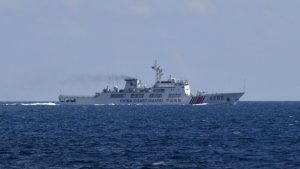A U.S. Navy Commander asserts that a U.S. warship, which became the focal point of a dispute with the Chinese military in the South China Sea over the weekend, was operating in accordance with international law.

As of a report dated November 26, the Chinese People’s Liberation Army Southern Theatre Command claimed on its WeChat social media account that its naval and air forces were dispatched to “track, monitor, and warn away” a U.S. destroyer.
China’s military contends that this incident serves as evidence that the “United States is unequivocally a ‘security risk creator’ in the South China Sea.”
This development occurred shortly after Beijing accused Manila of involving foreign forces in South China Sea patrols, specifically referring to joint patrols conducted by the Philippines and the U.S. militaries. Furthermore, the Philippines and Australia initiated their inaugural joint sea and air patrols in the region on Saturday.
The Chinese Communist Party (CCP), the singular ruling party in China, has been actively pursuing an assertive expansion strategy in the Indo-Pacific for an extended period. This strategy involves the construction of artificial islands to serve as military installations and attempts to pressure other regional nations into relinquishing power and territory.
The CCP has sought to establish historical claims over a significant portion of the South China Sea, overlapping with claims asserted by the Philippines, Vietnam, Indonesia, Malaysia, and Brunei regarding ownership in the same areas.
The contested area serves as a vital passage for over $3.3 trillion in global maritime trade annually.
In 2016, the Permanent Court of Arbitration declared that China’s assertion of control over the South China Sea lacked legal validity—a viewpoint consistently upheld by experts as tensions persisted in the region.
According to a press release from the Indo-Pacific Command, the Commander of the U.S. 7th Fleet Public Affairs stated that the USS Hopper, the involved destroyer, “affirmed navigational rights and freedoms in the South China Sea near the Paracel Islands,” aligning with international law.
